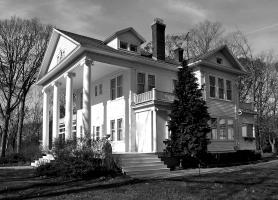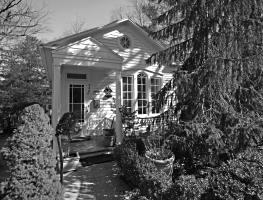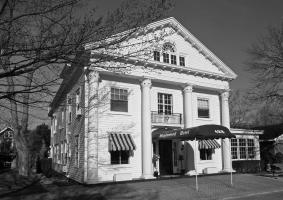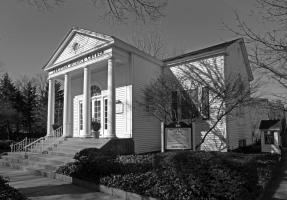
|
The
Cook-Bennett-Denison The Cook – Bennett – Dennison Mansion. (1916) Old
Dugout Road. One of Saugatuck area’s principal icons—standing high on the
bluff at the harbor entrance. David Cook was a Chicago publisher of Sunday
school literature and financial benefactor of the programs of Reverend
Gray’s Forward Movement Camp (now Presbyterian Camp). The Cooks owned much
of the lakefront and donated considerable riverfront property to
Saugatuck. The Colonial Revival mansion, which once was a mecca for rich
and powerful Democrats during the Truman administration, is now empty. |
|

|
The Fursman - Hoeksema
House (1855/1927). 246 Mary Street, Saugatuck. Soon after he acquired this
old school house, the important American painter Frederick Fursman had his
friend Thomas Eddy Tallmadge design a new Colonial Revival front for the
house (1927). The house (and studio to rear) continued as a residence for
artists, including Elsa Ulbricht and Rachel and Emily Fawcett. Finely
preserved under present owners. It was Tallmadge who helped the
Rockefellers reinvent Williamsburg, Virginia into what is today “Colonial”
Williamsburg and who designed the “Colonial Village” for the Chicago
Century of Progress Exhibition of 1933. |
|

|
The Maplewood Hotel. (1860/ facelift, 1923).
Originally a general store, furniture factory, and apartment house, it
became a hotel in 1898. George W. Maher, who is best known for the grand
residences he built for affluent Chicago families, designed this new
Colonial Revival front in 1923—which is continues to give Saugatuck its
sense of place. Maher had a summer home on the lakeshore. |
|

|
The Christian Science
Church. (1925). 12 Main Street (the Village Square), Saugatuck. Architect,
Howard Cheney. Another Colonial Revival classic from the 1920s. |
|
|
|
|